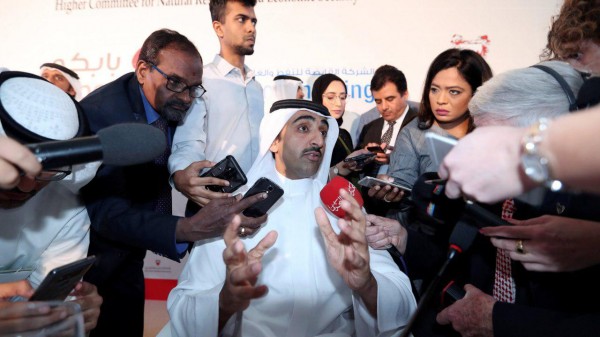�Khaleej Al Bahrain� Field Nears Saudi Maritime Border, So What�s Riyadh�s Stance?

2018-04-20 - 1:57 am
Bahrain Mirror (Exclusive): Saudi Arabia has so far refrained from making a formal statement on the huge oil discovery in Bahrain. Whether it is waiting for more information or further clarification, an important fact should be considered: the shale oil field stretching from the northwest to the southwest of Bahrain, which lies on the maritime frontier with Saudi Arabia. (Map 1).
Maps drawn by the Supreme Committee for Natural Resources and Economic Security, which oversaw the excavation of the field, show that the field extends topographically along the eastern border of Saudi Arabia, with the sea portion of the Arabian Gulf almost lying mid-field, dividing it in two halves. The first half is located in the discovered field, which extends in the form of horseshoe, while the other half is located in the territorial waters of Saudi Arabia. Which means that the maritime border between the two countries is adjacent to the explored area.
Tom Quinn, senior analyst, Middle East upstream, at Wood Mackenzie Ltd., told Offshore magazine that the discovered field was "not far from the Saudi maritime border."
It is not yet clear what Saudi Arabia's position on this discovery is, which has been sharing with Bahrain since 1996 another field- the Abu Safah marine field. However, the second important fact is that: the discovered shale oil field is geographically closer to both Saudi Arabia and Bahrain than the joint Abu Safah field, as the distance between each country and the Abu Safah field is about two times the distance between each country and the new discovered field. (Map 2)
"Core analysis by Schlumberger suggests the oil formation could be classified as a borderline conventional-unconventional play," Quinn continued.
The third important fact is that the oil exploration area is very large. If we take the joint Abu Safah field, for example, we are talking about a field area of 190 square kilometers with 6.1 billion barrels worth of oil.
The newly discovered field spans some 2,000 square kilometers, containing an estimated 80 billion barrels of rock oil and 10 to 20 trillion cubic feet of gas, according to the Bahraini statement. This means that its area is about tenfold larger than the Abu Safah field, also containing thirteen times more resources.
What's new in all of this is announcing "Khaleej Al Bahrain Basin" (Gulf of Bahrain) as the name of the explored area. It is a new name that has never been used for the coast indentation between Bahrain and Saudi Arabia. This is a fourth important fact. There is nothing in the previous adopted geographical maps of the two countries called "Khaleej Al Bahrain" (Gulf of Bahrain).
Up until the few days prior to the discovered oil, the name Khaleej Al Bahrain was used for the waterfront, developed since 2006 along the north coast of Manama, which is also called Bahrain Bay. It's the first time it is used as a name for the shared maritime borders between both countries.
There is no history of serious disagreement between the two gulf states over energy resources, except that the Kingdom of Saudi Arabia had granted Bahrain the whole production of the Abu Safah field of 300,000 barrels per day until 1996. Riyadh then decided in agreement with Manama to share the field by dividing it in half since then.
However, it is unknown whether this friendly understanding will last after Khaleej Al Bahrain, which Manama says is the largest in its history since the discovery of the first oil well in 1932. In such cases, disputes are usually managed internally amid the existing privacy of the Gulf ruling families. Nonetheless, when it comes to oil resources, we should not be so sure.
Not so long ago in October 2014, we witnessed tensions between Saudi Arabia and Kuwait over the giant Al-Khafji field, which has a capacity of around 700,000 barrels per day and is shared equally by the two countries. It reached to the point where Saudi Arabia closed down the field and stopped production while Kuwait threatened to resort to the International Court of Justice. There is also another dispute between the two countries over the Al-Dorra gas field, which is located in Al-Zour area, which is also a joint field between Saudi Arabia, Kuwait and Iran. Kuwait wants to use it commercially, but Saudi Arabia refuses to enter into any trilateral talks to which Iran is a party.
When it comes to energy resources, we should be more assured of the language of interests.

Map 1: Shows distance from each of Bahrain and Saudi Arabia to Abu Safah

Map 2: Shows extended area of discovered oil field
- 2024-05-08Bahrain: One Step Forward, Two Steps Back
- 2024-05-06Ali Haji May Face Imprisonment Again on Charges of "Penetrating a Restricted Area"
- 2024-05-01Was the Resumption of Flights with Iraq Expected?
- 2024-04-20Recent Releases in Bahrain: Something Has Changed
- 2024-04-04Return of Repression to Bahrain's Streets with the Crown Prince and Prime Minister's Blessing